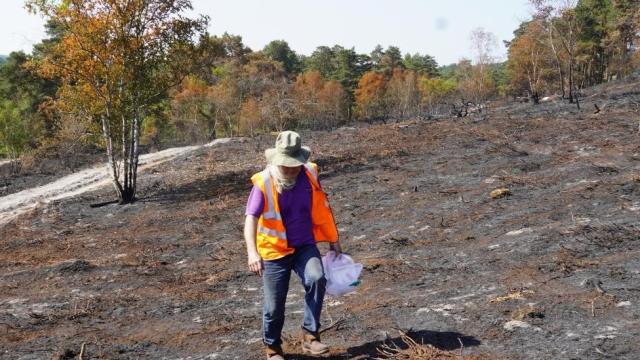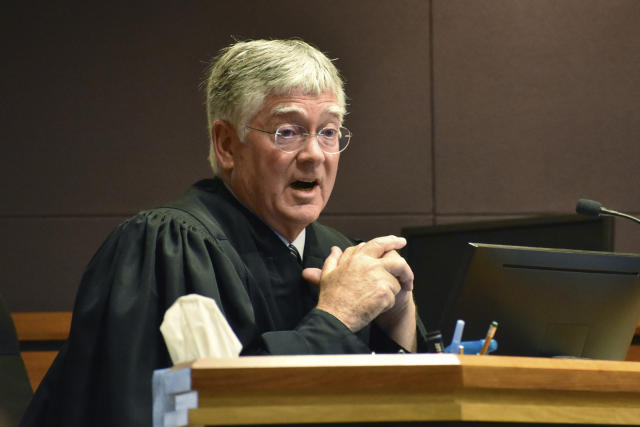Science Daily News | 10 Jun 2023

Views (184)

'The Hare Psychopathy Checklist': The test that will tell you if someone is a psychopath
Most people display some symptoms of psychopathy — superficiality, glibness, promiscuous sexual behavior, etc. — and that does not make you a psychopath.

Senior corporate leaders have been numbered among those who tend to show psychopathic traits.
The standard screening test for potential psychopaths is the Hare Psychopathy Checklist.
Read the list below to see the potential signs of adult psychopathy according to the checklist.
Many of the traits we seek in leaders, such as fearlessness, dominant behavior, and immunity to stress, are found in psychopaths.
The standard screening test for potential psychopaths is the Hare Psychopathy Checklist. In the test, a clinician interviews a potential sociopath and scores them on 20 criteria, such as "promiscuous sexual Behavior" or "impulsivity." On each criterion, the subject is ranked on a 3-point scale: (0 = item does not apply, 1 = item applies somewhat, 2 = item definitely applies). The scores are summed to create a rank of zero to 40. Anyone who scores 30 and above is probably a psycho.
The test is meant to be done by a professional psychologist but if you really want to take it yourself — or make a layperson's guess at your boss's psychological makeup — keep scrolling:
1. Do you have "excess glibness" or superficial charm?
(Answer: For sociopaths, the answer to this question is yes.)
2. Do you have a grandiose sense of self-worth?
(Psychopaths do.)
3. Do you have an excess need for stimulation or proneness to boredom?
(Psychopaths can't endure periods of the doldrums.)
4. Are you a pathological liar?
(Psychopaths don't care about the truth.)
5. Are you conning or manipulative?
(Psychopaths often believe they can pull the strings of the dupes around them.)
6. Do you display a lack of remorse or guilt?
(Psychopaths don't feel bad when they do bad things.)
7. Do you have "shallow affect?"
(Psychopaths show a lack of emotions when an emotional reaction is appropriate.)
8. Are you callous, or do you lack empathy?
(Psychopaths just don't care when bad things happen to other people.)
9. Do you have a "parasitic lifestyle"?
(Psychopaths prefer not to work for a living. They feel it is easier to take stuff from other people.)
10. Do you have poor behavioral controls?
(Psychopaths find it difficult to keep themselves in check.)
11. Do you have a history of promiscuous sexual behavior?
(Psychopaths like one-night stands.)
12. Do you have a history of early behavioral problems?
(As children, psychopaths often have a history of cruelty to others.)
13. Do you lack realistic long-term goals?
(Psychopaths prefer schemes over life or career goals.)
14. Are you overly impulsive?
(Psychopaths are very, very impulsive.)
15. Do you have a high level of irresponsibility?
(Psychopaths aren't big on doing the right thing.)
16. Do you fail to accept responsibility for your own actions?
(When you're a psycho, it's always someone else's fault.)
17. Have you had many short-term "marital" relationships?
(Psychopaths have an inability to commit to, or repeatedly betray, long-term relationships.)
18. Do you have a history of juvenile delinquency?
(Psychopaths start young.)
19. Have you ever experienced a "revocation of conditional release"?
(Even when psychopaths catch a break — like being let out of prison on probation — they tend to screw up.)
20. Do you display "criminal versatility"?
(Psychopaths differ from normal criminals because they don't really care which type of laws they break — they'll break any of them, under the right circumstances.)
If you scored more than 30 (i.e. you answered "somewhat" or "definitely" to most of these questions) then you might be a psychopath. If you scored lower than that, you are likely not a psychopath.
A gamma-ray explosion that was so bright it blinded scientists' equipment is even weirder than first thought
The brightest gamma-ray burst ever seen may have been powered by a unique jet structure, scientists say. The discovery could shed new light on the origins of the universe.

An explosion — about 100 times brighter than previously recorded — blinded scientists' instruments.
Scientists marveled at the power of the gamma-ray jet, which likely marked the birth of a black hole.
The explosion may have been so bright because it was powered by a unique jet structure.
The explosion earned the nickname BOAT for "Brightest of All Time."
Astronomers have since been trying to work out what could have made the gamma-ray burst so bright, and may finally have an answer.
Researchers have discovered that the gamma-ray explosion ejected a jet with an unusual structure which dragged a large amount of stellar material along with it. The discovery, the say, could shed new light on the origins of the universe.
"As we begin to probe this really high redshift, very distant, gamma-ray bursts, we can learn about how stars first formed, what environment they're forming in, what type of elements were existing at these times, and see how this star formation actually evolved over the history of the universe," he said.
Scientists have spotted about 10,000 of these gamma-ray bursts since the 70s. But this particular burst was relatively close, coming from a star about 2.4 million light-years away, which gives us an unprecedented look into the structure of these bizarre explosions.
"It's a hugely different event, and based on the brightness and its proximity to us, we expected it to be a once-in-a-century event," said O'Connor.
We don't see the explosion from gamma-ray bursts directly. Instead, we see the gamma rays and other rays like X-rays coming off the jet of hot gas released by the explosion, which we're usually only lucky to see if they're aiming straight at our planet.
The jet itself is usually over in a matter of seconds, but scientists can capture its afterglow, which drags stellar material behind it. This fades quickly, but the BOAT's afterglow lingered much longer than usual, puzzling scientists.
This mean they tend to be compact and very directed, spreading out neatly through the universe, with the afterglow dragging behind the first wave.
But the new analysis suggests that the BOAT jet was sloppier, spreading out from a "narrow core with wider, sloping sides," NASA said in a press release.
What scientists think happened is that, as the jet was being expelled, it mingled with stellar material which messed with its outflow.
"The only way to produce a different jet structure and vary the energy is to vary some property of the star that exploded, like its size, mass, density, or magnetic field," said Eleonora Troja, a professor of physics at the University of Rome, who led NuSTAR the observations of the event.
"That's because the jet has to basically force its way out of the star. So, for example, the amount of resistance it meets would potentially influence the features of the jet."
This is "exciting" because "we have no way of studying the star that produced this event; it's gone now. But we now have some data giving us clues about how it exploded," said O'Connor, who was an author on this study.
The analysis demonstrates that the most extreme explosions do not obey the standard physics assumed for normal gamma-ray bursts, he said.
Van Eerten agrees: "Our model helps not just to understand the BOAT, but also previous brightness record holders that had astronomers mystified about their lack of jet signature.
Still, according to O'Connor, this finding "a massive step forward in our understanding of gamma-ray bursts," the "equivalent Rosetta stone of long GRBs."
O'Connor expects BOAT will yield more discoveries yet, as the afterglow is predicted to remain visible to scientists for at least another year.
Montana gas power plant can resume construction, judge rules
NorthWestern Energy will resume construction of a natural gas power plant along Montana's Yellowstone River following a two-month delay, a company spokesperson said Friday, after a state judge revived a pollution permit for the project despite lingering concerns over its planet-warming emissions. Work on the $250 million plant near the town of Laurel was largely halted in April when Judge Michael Moses cancelled its permit and said officials had failed to adequately consider the 23 million tons of greenhouse gases it would emit over several decades. The judge cited a “changing legal landscape” that includes a new state law that eliminated a requirement for state officials to look at climate impacts from emissions.

Work on the $250 million plant near the town of Laurel was largely halted in April when Judge Michael Moses cancelled its permit and said officials had failed to adequately consider the 23 million tons of greenhouse gases it would emit over several decades.
Anne Hedges with the Montana Environmental Information Center said the group was considering its next steps.
The Montana plant would produce up to 175 megawatts of electricity. Its air permit was challenged in a 2021 lawsuit from the Montana Environmental Information Center and the Sierra Club.
Moses said restoring the permit could also help avoid future cost increases to customers of Sioux Falls, South Dakota-based NorthWestern, which had warned that the construction delay would drive up the project’s price.
A spokesperson for the Montana Department of Environmental Quality, Rebecca Harbage, said the agency was pleased the judge recognized his earlier ruling's potential negative impacts on customers.
Steve Krum, a Laurel resident who’s opposed to the plant, said he wasn’t surprised by the judge’s ruling after Montana legislators excluded climate change from permitting decisions.
Lawmakers are “looking out for NorthWestern Energy,” Krum said. “They are giving them what they want.”
A legal challenge by plant opponents is still pending, he said, regarding the decision to build the plant close to town.
“Why would they put a major source of hazardous air pollution right in a populated area?” Krum asked.
The plant is expected to begin serving customers sometime next year, said Jo Dee Black, a spokesperson for NorthWestern.
“We need that additional capacity in Montana, dedicated to serving our Montana customers, for both reliability and affordability,” said Black, adding that the plant would ensure enough electricity is available at times of high demand, such as on hot days or cold nights.
Greta Thunberg says she's graduating from school strikes for climate
Young Swedish activist Greta Thunberg says a major landmark in her life means she'll "no longer be able to school strike for the climate."

"Today, I graduate from school, which means I'll no longer be able to school strike for the climate," Thunburg wrote on social media. "Much has changed since we started, and yet we have much further to go."
She has since become an outspoken advocate for action on climate change, traveling around the world to meet global leaders to spread her message, usually traveling sustainably by boat or train .
She said Friday's strike, number 251, would be her last.
"We are still moving in the wrong direction, where those in power are allowed to sacrifice
marginalized and affected people and the planet in the name of greed, profit and economic growth," Thunberg said Friday. "There are probably many of us who graduate who now wonder what kind of future it is that we are stepping into, even though we did not cause this crisis."
Thunberg said even though she'd no longer be able to strike from school each Friday, she would continue to work to get global leaders to address climate change.
"We who can speak up have a duty to do so. In order to change everything, we need everyone. I'll continue to protest on Fridays, even though it's not technically 'school striking.' We simply have no other option than to do everything we possibly can. The fight has only just begun."
Swan trapped in drain for hours rescued by charity
The bird seemed to have been stuck for several hours in the grounds of a converted wind pump.

A swan had to be rescued after being found trapped in a drain in a remote area of Norfolk.
The Marine and Wildlife Rescue charity was called to the grounds of a converted wind pump on Haddiscoe Island, near Haddiscoe, Norfolk, on Tuesday.
The charity said it was thought the bird had been trapped for several hours.
After being given food and water, the swan was monitored before being returned to the marshes.
"Due to how he had got himself wedged, it would have been impossible for him to have got free by itself as he was tightly confined," the charity said.
Wildfires: UK to set up new Mediterranean-style specialist units
Fire chiefs are set to increase the number of specialist teams trained in 'fighting fire with fire'.

Firefighters will deploy new techniques learnt in the world's worst wildfire hotspots as climate change raises the risk level in the UK this summer.
Last year's heatwaves saw thousands of fires break out, with one destroying homes at Wennington, east London.
This year has already seen hundreds of grass fires and one of the UK's largest ever has been burning near Cannich in Scotland for the past two weeks.
More fire crews are now training in skills from southern Europe and the US.
Fire chiefs are particularly looking to expand the number of specialist teams trained in "burn suppression" techniques - the deliberate burning of land to keep a fire contained.
At the moment, just five UK units across more than 50 fire and rescue services specialise in the "fighting fire with fire" technique, mostly in moorland areas.
With more than 90 buildings destroyed by wildfires close to urban areas last July, more units - including those in services that straddle urban and rural areas - would be trained in new ways of wildfire fighting.
They could then be deployed nationally, in the event of a significant fire.
Chief Fire Officer Paul Hedley, wildfire lead for the National Fire Chiefs Council (NFCC), said the risk and threat of such major wildfires was "clearly growing in the UK".
"All of this learning from international partners, who are probably still some years ahead of us, is a very sensible way of trying to get us ahead of the curve," he said.
It is hoped a UK-wide training programme will be set up as part of a national action plan drawn up in response to the lessons learnt from last year's blazes.
One of the services leading the way is Surrey Fire and Rescue, which has already dealt with more than 80 wildfires this year.
The most recent wildfire was last month at Frensham Common, near Farnham, a popular beauty spot.
The cause of the 10-hectare fire is not yet known - but the damage is clear to see.
Where once there was rich heathland, home to rare species, including sand lizards, there is now desolation.
When the BBC visited, volunteers from the Amphibian and Reptile Conservation charity were walking the scorched earth, stretched out in a line like a police forensics team, searching for creatures that survived the blaze.
If the immediate impact is shocking, the long-term effects are equally concerning.
"Whilst we can save some of these animals that survived the fire, we lose an awful lot and we lose all that biodiversity. It takes years, if not decades, for that to come back again," explained trustee Howard Inns.
For countryside ranger Darren Hill, who supported firefighters tackling the blaze here, seeing the aftermath, and knowing more wildfires could be on their way, is hard to take.
"To come back and see a site like this, and know I found this species over here and we had smooth snakes over there, it does take its toll," he said.
Meanwhile, using a drone with thermal imaging to survey the site for hidden subterranean burns is Matt Oakley, a fire investigations officer for Surrey Fire and Rescue.
He is one of the UK's national wildfire tactical advisors - a group of specialist officers who already have the skills learnt abroad and who will be training units.
He says the kind of techniques he's seen used in hotspots as far-flung as France and South Africa will be vital in the UK in the years to come.
"Our climate is changing - it's changing beyond recognition," he explained. "What used to be a nine to 12-year cycle, this is every year now.
"We are heading towards a northern Mediterranean climate in the southeast of England within the next decade and this will be business as usual day in, day out."
Many of the wildfire-fighting methods being rolled out across the UK rely on a 'toolbox' of skills, from creating natural firebreaks and reducing the 'fuel-load' of vegetation to setting controlled burns deliberately around wildfires to stop their spread.
Together they would reduce the need for huge amounts of water in a drought and reduce the number of appliances needed on site.
But the Fire Brigades Union says new training and techniques are not enough to tackle the rising challenges of climate change. It says more crews are needed after years of cuts that have seen the loss of thousands of firefighters since 2010.
Matt Wrack, the Fire Brigades Union's general secretary, called for more funding from the government, saying: "Rising temperatures and the systematic underfunding of the fire and rescue service are a recipe for destruction."
The government said it was giving fire and rescue authorities around £2.6bn this year, and each authority was able to decide what it spent it on.
A spokesperson said: "The Home Office works closely with the National Fire Chiefs Council and England and Wales Wildfire Forum to continue to improve our response to wildfires and mitigate them."
0 Likes
